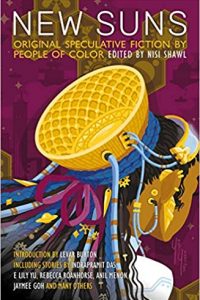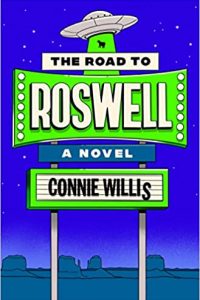Gary K. Wolfe reviews Margo Lanagan
 Margo Lanagan always seems to be a couple of steps ahead of us, like a tricksterish lightning bug that is never in the jar you thought you’d put it in. A little over a year ago, Interfictions 2 published a story by Will Ludwigsen in which a house uproots itself and starts traveling to Florida, and while competently executed, it was clear that the story really began and ended with that conceit. Here’s what Lanagan does in ‘‘Eyelids of the Dawn’’, the final story in her new collection Yellowcake: an entire shopping mall, annoyed by the itching caused by the ‘‘lice’’ who wander through it every day, decides to uproot itself and go for a cleansing swim in the ocean. The shopping mall even narrates its portions of the tale, in a rich, figurative language that weirdly conveys an idea of what architecture might think about. But then Lanagan introduces two other viewpoints (in third person): a nursing mother trying to keep her baby still during the night and a ‘‘half-mad’’ milkman making his early rounds, each witnesses to the event, each embroiled in their own half-told tales, each described in subtly differentiated style and tone, suggesting that there may be a great deal more going on here than just a peripatetic mall. Similarly, in ‘‘An Honest Day’s Work’’, she begins with a bizarre premise which by itself might satisfy most writers – a village which makes its living disassembling and recycling giant human-like corpses which wash ashore, a conceit that evokes both whale-rendering and shipbreaking (which in a note Lanagan explains was the real source of the idea). But the narrator is a young crippled boy (‘‘handicapped’’ is hardly a word that would be used in this world), who by getting a job as an ‘‘onlooker’’ – a spotter who warns the work teams of impending hazards – finds a role in his community and a measure of self-respect as he finally goes out for a beer ‘‘along with the other men’’.
Margo Lanagan always seems to be a couple of steps ahead of us, like a tricksterish lightning bug that is never in the jar you thought you’d put it in. A little over a year ago, Interfictions 2 published a story by Will Ludwigsen in which a house uproots itself and starts traveling to Florida, and while competently executed, it was clear that the story really began and ended with that conceit. Here’s what Lanagan does in ‘‘Eyelids of the Dawn’’, the final story in her new collection Yellowcake: an entire shopping mall, annoyed by the itching caused by the ‘‘lice’’ who wander through it every day, decides to uproot itself and go for a cleansing swim in the ocean. The shopping mall even narrates its portions of the tale, in a rich, figurative language that weirdly conveys an idea of what architecture might think about. But then Lanagan introduces two other viewpoints (in third person): a nursing mother trying to keep her baby still during the night and a ‘‘half-mad’’ milkman making his early rounds, each witnesses to the event, each embroiled in their own half-told tales, each described in subtly differentiated style and tone, suggesting that there may be a great deal more going on here than just a peripatetic mall. Similarly, in ‘‘An Honest Day’s Work’’, she begins with a bizarre premise which by itself might satisfy most writers – a village which makes its living disassembling and recycling giant human-like corpses which wash ashore, a conceit that evokes both whale-rendering and shipbreaking (which in a note Lanagan explains was the real source of the idea). But the narrator is a young crippled boy (‘‘handicapped’’ is hardly a word that would be used in this world), who by getting a job as an ‘‘onlooker’’ – a spotter who warns the work teams of impending hazards – finds a role in his community and a measure of self-respect as he finally goes out for a beer ‘‘along with the other men’’.
Yellowcake is Lanagan’s fourth story collection and the first, I believe, in which most of the ten selections were previously published; only one, ‘‘Into the Clouds on High’’, sees its first publication here. As with the earlier collections, many of the stories take place in that uniquely-defined Lanagan-space in what appears to be a folktale village that features computers or ‘‘talkie-walkies’’ or in which Charon’s bumpkin daughter wears a pinafore and is named Sharon Armstrong (in ‘‘Ferryman’’). In a few cases – such as ‘‘Ferryman’’ – Lanagan does make use of familiar source material, but in almost every case the point of view and language take it in unexpected directions (who else would think that ferrying the souls of the dead would become a problem of inheriting the family business?) ‘‘The Golden Shroud’’ is a version of Rapunzel in which the prince sets out to rescue his beloved from the witch, but in which both end up being rescued by her hair, which takes on a determined life of its own. ‘‘Night of the Firstlings’’ re-imagines the Passover and Exodus story as a distinctly non-Hebrew rustic family drama, with the kids worried about Gramp, Mum worried about dinner, and everyone worried about the Gypsies down the road – though it also contains some of the most literally visceral and characteristic Lanagan prose in the book: ‘‘The air of the room was clear, though it ought to have been black, or green and red, beslimed, chockablock with limbs and bits, a-streak with organs and tubing and drippings and sludges.’’ Probably the closest to a traditional SF setting is ‘‘Heads’’, with its grim, shattered post-apocalyptic world terrorized by gang members called Duwazzi and its young boy protagonist who, oddly, finds a kind of acceptance among them because of his pristine golden hair. ‘‘Living Curiosities’’ has a setting that would seem tailor-made for Lanagan’s sensibilities – a freak show at a circus – but even here the tale takes unexpected turns involving ghostly carriages, a circus owner who believes that all the circus acts can be found within him personally (‘‘I am all acts, all persons, all creatures, all curiosities, rolled into one’’), and an unexpected suicide.
By Lanagan standards, probably the most linear tales here are ‘‘Into the Clouds on High’’ (the one original story), in which a mother periodically begins floating upward, called by some unseen force which wants her to do good (the father tries to re-anchor her to our world with flowers and aftershave), and ‘‘A Fine Magic’’, in which a ‘‘fascinator’’ (Lanagan’s delicious term for a kind of sorcerer) is spurned by two beautiful sisters and takes a surrealistic and oddly beautiful sort of revenge. ‘‘The Point of Roses’’, which was first published in the British edition of Black Juice, also begins with what appears to be a rather straightforward supernatural premise – a group of kids collect various objects to conduct experiments on a nearby hill to test whether a local Ukrainian immigrant boy really has psychic powers – but morphs into what may be the most complex, and possibly most redemptive, tale in the book. One of the amulet-objects is a rose, and when a great transformative rose-wind blasts from the hill, it brings hidden insights, as when one of the boys’ fathers, frightened, comes to terms with his own immaturity. ‘‘I didn’t know… what was the uses of roses,’’ he stammers to his wife. ‘‘I couldn’t see the point, before, you see – .’’ It’s an oddly mundane sentence in the midst of a book filled with the stormy, rhapsodic language that’s become one of Lanagan’s most distinctive trademarks, but it makes its point, and it’s sort of the point of the whole beautiful book.








Pingback:Locus Online Reviews » Gary K. Wolfe reviews Margo Lanagan | For Omina Quries
Pingback:SF Signal: SF Tidbits for 3/26/11